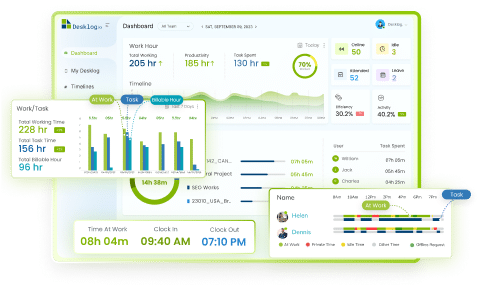Feeling like there just aren’t enough hours in the day to conquer both your career and personal life? You’re not alone. In a recent survey, a whopping 85% of professionals reported struggling with work-life balance. That’s right, nearly everyone wrestles with this challenge. But fear not, fellow warriors of the workday!
This blog is your one stop shop for conquering the ever-elusive work-life balance. We’ll discuss the most common problems you might face, and equip you with actionable solutions to achieve the balance between your professional and personal spheres. So, grab a cup of coffee, and get ready for a harmonious blend of work and well being.
What is Work Life Balance?
Work-life balance is typically defined as the amount of time you spend doing your job versus the amount of time you spend doing what’s important to you outside of work, whether that is with loved ones or pursuing personal interests and hobbies.
In the intersection of work and personal life, the work life balance is the equilibrium between the two. There are many aspects of one’s personal life that can intersect with work, including family, leisure, and health .

Did You Know ?
Why Is Work Life Balance So Important?
Work-life balance is crucial for several reasons:

Health and Well-being:
Maintaining a balance between work and personal life helps prevent burnout, stress, and mental health issues. It allows individuals to recharge, relax, and take care of their physical and emotional needs

Increased Productivity:
When people have time to rest and recharge outside of working hours, they return to work more focused, energized, and motivated. This rejuvenation leads to higher productivity and better quality work.

Enhanced Relationships:
Balancing work and personal life enables individuals to spend time with family and friends, nurturing these relationships. Strong social connections contribute to overall happiness and well being.

Personal Growth:
Pursuing hobbies, interests, and personal development outside of work enriches life experiences and fosters personal growth. It helps individuals maintain a sense of fulfillment and satisfaction.

Reduced Turnover:
Organizations that prioritize work-life balance have higher employee retention rates. Employees are more likely to stay who support their well-being and offer flexibility in managing work and personal responsibilities.

Attracting Talent:
In a competitive job market, offering work-life balance initiatives can be a key factor in attracting top talent. Many professionals prioritize work-life balance when considering job opportunities.

Positive Company Culture:
When work-life balance is encouraged and supported by the organization, it contributes to a positive company culture. Employees feel valued, respected, and appreciated, leading to higher morale within the workplace.

Improved Physical Health:
Individuals experience improved well-being when they have time for exercise, proper nutrition, & adequate sleep. Regular physical activity & rest prevent burnout & reduce stress levels, which are known contributors to various health issues.

Career Advancement:
Work-life balance is important for a long-term career advancement. Those who prioritize work-life balance often demonstrate strong time management skills, resilience, and the ability to maintain perspective.

More Creativity:
Pursuing hobbies, interests, and experiences beyond the workplace stimulates the mind, broadens perspectives, and encourages creative thinking. This provides individuals with fresh insights and ideas that can be applied to their work.

Happiness:
When individuals have the time and flexibility to pursue activities that bring them joy and fulfillment outside of work, they experience greater satisfaction with their lives, ultimately contributing to overall happiness and well-being.
What Is An Unhealthy Work Life Balance?
An unhealthy work-life balance occurs when the demands of work overshadow other important aspects of life, such as family, relationships, hobbies, and self-care. It impacts in various ways, each with its own set of consequences. Here are some common signs indicating that your work-life balance may be out of sync:

Did You Know ?
Excessive Working Hours
Constantly working long hours, including evenings and weekends, is a clear indicator of an unhealthy work-life balance. While occasional overtime may be necessary, consistently sacrificing personal time for work can lead to burnout.
Neglecting Personal Relationships
When work takes overweigh over spending time with loved ones, it can strain relationships and lead to feelings of isolation. Neglecting family and friends in favor of work obligations can erode the quality of these connections and contribute to loneliness.
Physical and Mental Exhaustion:
Feeling constantly exhausted, both physically and mentally, is a red flag for an unhealthy work-life balance. Chronic stress, lack of sleep, and neglecting self-care practices can take a toll on overall well-being and lead to a decline in performance and productivity.
Inability to Disconnect:
Constantly checking emails, responding to messages, and thinking about work-related matters outside of office hours can prevent individuals from fully engaging in leisure activities and relaxation.
Decline in Health:
Poor dietary habits and lack of exercise can contribute to health issues such as obesity, high blood pressure, and heart disease. Mental health can also suffer, with increased rates of anxiety, depression, and burnout among those experiencing work-life imbalance.
Work Life Balance Problems And Solutions
Work-Life Balance Problem: Persistent Fatigue:
Problem
Feeling constantly tired is a common indicator of an unhealthy work-life balance. It can result from overworking, lack of adequate rest, and neglecting self-care practices.
Impact on the Organization
Persistent fatigue can lead to decreased productivity, reduced motivation, and increased risk of errors. Employees who are constantly tired may struggle to focus on tasks, leading to low performance and potential delays in project completion.
Solution
Encourage employees to prioritize rest and relaxation outside of work hours. Implement policies that promote work-life balance, such as offering break time and prevent overtime, providing flexible scheduling options, and promoting a culture of self-care.
Work-Life Balance Problem: Frequent Overtime
Problem
Working overtime on a regular basis can lead to burnout, exhaustion, and decreased job satisfaction. It indicates a lack of balance between professional responsibilities and personal life.
Impact on the Organization
Excessive overtime can result in increased costs due to overtime pay, as well as decreased employee engagement and satisfaction. It may also indicate inefficiencies in workload distribution or poor time management practices.
Solution
Track workload distribution to ensure it is manageable within regular working hours. Encourage employees to prioritize tasks effectively and delegate when necessary. Implement policies to discourage excessive overtime and promote a healthy work-life balance.
Work-Life Balance Problem: Irritability
Problem
Feeling irritable is a common symptom of stress and burnout, often stemming from an imbalance between work and personal life. It can affect interpersonal relationships and communication in the workplace.
Impact on the Organization
Irritability among employees can lead to tension, conflicts, and a negative work environment. It may result in decreased collaboration, morale, and overall team harmony.
Solution
Provide training and resources for stress management and emotional intelligence to help employees cope with work-related pressures. Encourage open communication and promote a supportive work culture that values empathy, understanding, and mutual respect.
Work-Life Balance Problem: Disorganized Personal Space
Problem
A messy personal space can contribute to feelings of overwhelm and stress, making it difficult to relax and unwind outside of work hours.
Impact on the Organization
Disorganization in personal spaces can affect employee morale and productivity. It may also reflect poorly on the organization’s culture and image, particularly if clients or visitors are present.
Solution
Encourage employees to organize their personal spaces to create a more productive environment for relaxation and well-being. Provide resources for time management and organization skills training to help employees maintain tidy workspaces
Work-Life Balance Problem: Neglected Personal Relationships
Problem
Neglecting personal relationships can lead to feelings of isolation, loneliness, and dissatisfaction with life outside of work. It indicates an imbalance between professional and personal priorities.
Impact on the Organization
Poor personal relationships can affect employee morale, engagement, and overall employee satisfaction. It may also contribute to increased turnover rates as employees seek fulfillment and connection elsewhere.
Solution
Encourage employees to prioritize quality time with loved ones and maintain a healthy work-life balance. Offer flexible scheduling options and support initiatives that promote family-friendly policies.
Work-Life Balance Problem: Decreased Productivity and Employee Well-being
Problem
A decline in productivity and employee well-being indicates that individuals may be struggling to manage their workload or maintain a healthy work-life balance. It can result in decreased performance and satisfaction.
Impact on the Organization
Decreased productivity and employee well-being can have serious consequences for the organization, including reduced competitiveness, increased costs, and diminished reputation.
Solution
Address underlying issues contributing to decreased productivity and employee well-being, such as excessive workload, lack of support, or poor work-life balance. Implement strategies to improve time management, implement 1 3 5 rules, and promote employee engagement and satisfaction. Provide resources for stress management, mental health support, and work-life balance initiatives to support overall well-being.
Work-Life Balance Problem: High Levels of Stress
Problem
Work-Life Balance Problem: High Levels of Stress
Impact on the Organization
Chronic stress can lead to decreased morale, engagement, and productivity among employees. It may also contribute to increased absenteeism, turnover rates, and healthcare costs for the organization.
Solution
Implement measures to reduce workplace stress and promote a healthy work-life balance, such as flexible scheduling, wellness programs, and stress management training.. Foster a supportive work culture that values employee well-being and recognizes the importance of work-life balance.
Work-Life Balance Problem: High Turnover, Absences, and Sick Leave
Problem
High turnover, absenteeism, and sick leave can be indicative of an unhealthy work environment or poor work-life balance. It suggests that employees may be experiencing dissatisfaction or stress-related health issues.
Impact on the Organization
High turnover, absences, and sick leave can disrupt operations, and decrease productivity. It may also indicate underlying issues with workplace culture, management practices, or work-life balance policies.
Solution
High turnover, absences, and sick leave can disrupt operations, and decrease productivity. It may also indicate underlying issues with workplace culture, management practices, or work-life balance policies.
Work-Life Balance Problem: Loss of Passion for the Job
Problem
A loss of passion for the job can indicate that individuals may be experiencing burnout or dissatisfaction with their work-life balance. It suggests a disconnect between personal values and professional responsibilities.
Impact on the Organization
A loss of passion for the job can lead to decreased motivation, engagement, and performance among employees. It may also contribute to increased turnover rates and difficulty attracting and retaining top talent.
Solution
Cultivate a positive work environment that values employee engagement, creativity, and personal development. Provide opportunities for employees to pursue their interests, develop new skills, and achieve a sense of purpose and fulfillment in their work. Encourage open communication and feedback to address issues and support employees in maintaining a healthy work-life balance.
Work-Life Balance Problem: Loss of Passion for the Job
Problem
A decrease in creativity and innovation can occur when individuals are overwhelmed by work demands and unable to find time for activities that stimulate their creativity. This may result in stagnant ideas, lackluster problem-solving, and decreased motivation to explore new possibilities.
Impact on the Organization
Decreased creativity and innovation can hinder the organization’s ability to adapt to changing market dynamics, address challenges, and seize opportunities for growth. It may lead to stagnation, decreased competitiveness, and missed opportunities for improvement and innovation.
Solution
Create a culture that values and encourages creativity and innovation by providing opportunities for employees to explore new ideas and approaches. Implement initiatives such as brainstorming sessions, cross-functional collaboration, and innovation challenges to stimulate creativity and problem-solving. Encourage employees to prioritize time for activities outside of work that inspire creativity, such as hobbies, artistic pursuits, and exposure to new experiences.
How To Improve Your Work Life Balance?
Achieving a harmonious work-life balance is a pursuit that many of us aspire to, yet it often feels like a challenging goal. In today’s technical world, where technology blurs the boundaries between work and personal life, finding equilibrium can be daunting. However, with mindful planning and intentional strategies, it’s possible to improve your work-life balance. Let’s explore some practical solutions to help you strike that balance between your professional responsibilities and personal well-being.

Plan Ahead
Planning is key to managing your time effectively and maintaining a healthy work-life balance. Take time at the beginning of each week to outline your priorities, deadlines, and commitments. Break down large tasks into manageable chunks and allocate time for both work and personal activities. By planning ahead, you can minimize stress and ensure that you have dedicated time for all aspects of your life

Embrace the Way Your Brain Works
Recognize that your brain operates most efficiently when it has time to rest and recharge. Instead of trying to power through long periods of uninterrupted work, embrace the concept of strategic breaks. Incorporate short breaks into your workday to recharge your mental energy and enhance productivity. Experiment with techniques such as the Pomodoro Technique, which involves working in short bursts followed by brief breaks

Set Time Blocks for Different Tasks
Segmenting your day into distinct time blocks for different tasks can help you stay focused and productive. Allocate specific time slots for tasks such as email correspondence, meetings, and focused work. By setting boundaries around your time and tasks, you can avoid multitasking and ensure that each task receives your full attention.

Pro Tip
Try keeping backlogs for your projects so that you can work without stress while juggling with multiple tasks.

End Work at a Certain Time
Establishing a firm end time for your workday is essential for maintaining boundaries between work and personal life. Determine a realistic time to wrap up work each day, and commit to honoring this boundary. Set reminders or alarms to signal the end of your workday, and use this time to transition into leisure activities or spend time with loved ones.

Enlist Technology to Help You Unplug
While technology can contribute to work-life imbalance, it can also be a valuable tool for setting boundaries and reclaiming personal time. Utilize features such as Do Not Disturb mode, automatic email filters, and productivity apps to minimize distractions and create designated periods of uninterrupted focus. Establish clear guidelines for when you will and will not engage with work-related communication outside of designated work hours.

Enjoy Lunch with Coworkers
Take advantage of your lunch break as an opportunity to recharge and connect with others. Step away from your desk and enjoy a change of scenery by going out for lunch or taking a leisurely stroll. If possible, invite coworkers to join you for lunch to maintain social connections. Use this time to decompress, recharge, and return to work feeling refreshed and rejuvenated.

Take Time Off
Prioritize taking regular breaks to recharge yourselves and prevent burnout. Whether it’s a long weekend getaway or a week-long vacation, allow yourself time to disconnect from work and focus on relaxation. Use vacation time to pursue hobbies, spend time with loved ones, and explore new experiences. By prioritizing time off, you can return to work feeling energized, inspired, and ready to tackle new challenges.

Utilize Time Tracking Software
Time tracking software can be a valuable tool for gaining insight into how you’re allocating your time and identifying areas for improvement. By tracking your work activities and time spent on various tasks, you can gain a clearer understanding of your productivity patterns and identify opportunities to optimize your workflow. Additionally, time tracking software can help you set realistic goals, prioritize tasks, and establish boundaries around your work hours.

Pro Tip
Time tracking software can also improve your productivity. Well, read our blog ‘advantages of time tracking software’ to know the myriad of benefits this software offers..
Finding Work-Life Balance While Working Remotely

While working remotely, finding equilibrium between professional obligations and personal life is a challenge. When your home becomes your office, it’s easy for work to spill over into personal time. This can lead to longer work hours, diminished breaks, and difficulty disengaging from work during off-hours. Additionally, the absence of traditional office camaraderie can nurture feelings of isolation and loneliness, impacting mental well-being.
To counteract these challenges, establishing clear boundaries is paramount. Remote workers should define specific work hours and designate a dedicated workspace to signal the transition between work and personal life. Staying connected with colleagues and loved ones through virtual interactions can alleviate feelings of isolation and create a sense of community.
Regular breaks, both mental and physical, are essential for recharging and maintaining productivity. Utilizing time tracking software can help track work hours and prevent overwork. Furthermore, prioritizing self-care through activities like exercise, mindfulness, and hobbies is crucial for nurturing overall well-being. By implementing these strategies, remote employees can cultivate a healthier work-life balance and thrive in their professional and personal pursuits
Endnote
Achieving work-life balance is an ongoing journey that requires mindful attention and intentional actions. By addressing common work-life balance problems and implementing the solutions outlined in this blog, you can reclaim control over your time and prioritize your well-being. Take the first step today and begin incorporating these techniques into your daily routine. Your journey toward work-life balance starts now.
1What are the reasons for lack of work-life balance?
Personal factors and choices play a significant role in shaping work-life balance. Individual aspects like personal priorities, perfectionism, fear of missing out (FOMO), or a deep sense of commitment to work can contribute to work-life imbalance.
2How do people struggle with work-life balance?
Struggling with work-life balance can lead to a constant rush to manage different commitments, often leaving you feeling inadequate in all areas of life. Long work hours can be more difficult to achieve a healthy equilibrium between your professional and personal life.
3How does a poor work-life balance affect employees?
An ACAS report examining flexible working and work-life balance highlights the detrimental effects of an inadequate balance, including increased absence, reduced productivity, and heightened stress levels. Conversely, attaining balance yields numerous advantages, such as enhanced efficiency and productivity, along with decreased levels of absence, sickness, and stress.
4 What are the three types of work-life balance?
- Pairing work with passion
- A separated work-life balance
- Flexibility & work-life balance
5How to encourage work-life balance?
Ways to help your employees balance work and life
- Recognize that each employee is different
- Offer flexible work schedules and hybrid working
- Focus on productivity rather than long hours of work
- Insist on breaks
- Allow free time for volunteering and giving back
- Offer useful benefits
- Support parents
















